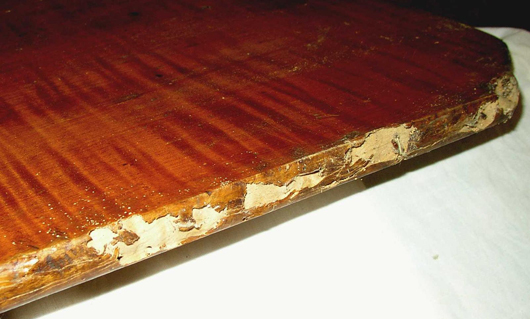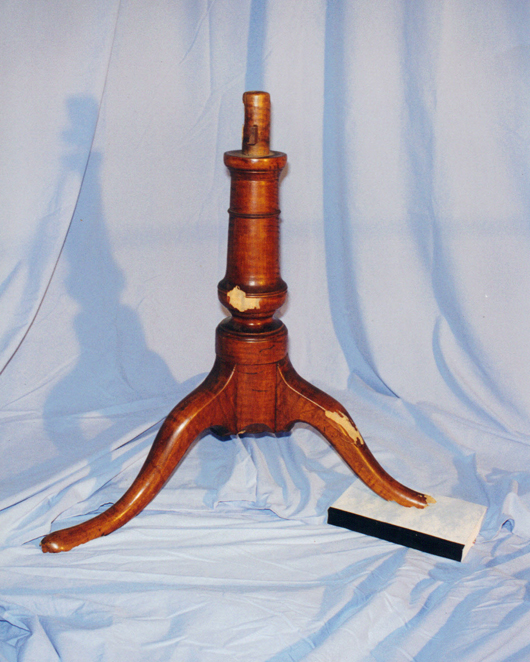
Part of the adventure of antique furniture is studying to learn more about it. Then you get to look around and decide what you like. Then all you have to do is acquire it, get it home safely and live happily ever after. Right?
I don’t think so. After you get it home the second half of the project begins. That second half, in addition to care and maintenance, involves defense. Believe it or not there is an entire category of creatures out there, or more correctly in your home, who, as they go about their daily business, either accidentally or on purpose attack, injure or destroy your furniture.
Those creatures can loosely be grouped together in the category of “furniture pests” and can be broken down further into classes with the names Insects, Pets and Humans.
INSECTS
Insects are the most devious because they are small, work out of sight and have evolved over millions of years to be invisible and indestructible. If left to work undisturbed they can, over a long period of time, destroy a valuable antique and anything else that stands still for that long.
Destructive insects fall into two categories, beetles and termites. The most commonly known beetles are the so-called “powder post” beetles. Their ability to render the insides of a nice piece of wood furniture into a substance the consistency of baby powder is the reason for their name. These little beasties are brownish, dry wood-eating insects ranging in size from one-twelfth to one-fifth inch long. You won’t know you have them until they are gone because the main evidence is the exit hole as they leave the furniture. The adults mate and the female lays her eggs in cracks, crevices or old exit holes where they hatch into larvae and eat their way through the yummy cellulose before they pupate and emerge as beetles to start over again. You can treat the area with insecticide, but you are better off asking a professional exterminator for help.
Another pesky beetle is the carpet beetle, small, oval-shaped beetles about one-eighth inch long, usually shiny black in the most common form. Here too the destructive phase is in the larvae, which may grow to one-half inch long. They have a voracious appetite for any substance that contains keratin, a principal protein found in animal hair and feathers. Upholstery and carpet are the main targets, especially those that contain wool and horsehair. Vigilance and cleanliness are the best routes for detection and disposal.
In southern regions of the country dry wood termites, known in the 19th century as “furniture termites” because of their propensity to eat furniture regularly, can be a constant problem. The only solution is fumigation by an exterminator.
So much for the wild critters. Now let’s look at some of the invited domestic pests.
PETS
As destructive as the insect pests can be, the next category of pests, while generally loveable, can also do some serious damage. We all love our pets, otherwise we wouldn’t have them. Besides what harm can they do?
Dogs are the primary, but certainly not the only, culprits. Dogs just have this desire to gnaw – and gnaw – and gnaw. They start as puppies with needle-sharp teeth and continue through life gnawing on bones, real or rawhide, toys, sticks, shoes, houses (my brother’s two boxers ate off the corner of his house), woodwork and sometimes furniture. Sometimes I think they just gnaw out of boredom. Good behavior is highly prized in house dogs but even the best of them get bored occasionally and chew on the footboard. I once repaired a king-size bed that belonged to a police officer. His German shepherd basically just ate the blanket rail on the bed one day. No reason. I fixed it nicely and that was that. Until two years later. The same cop brought back the same footboard with the same blanket rail chewed in all the areas that had not been patched with filler earlier. I asked him why he had not trained that dog better in the past two years. Turns out it wasn’t the original dog this time. It was the dog’s son, born after I did the first fix. Maybe it was genetic.
Upholstery can also take a beating from pets. Sometimes it’s just too much to ask that they not tear up the pillow or take the occasional nap on the couch. And cats just love to stretch their claws on rough fabric. It’s good exercise, you know.
Dogs, and sometimes even cats, do have “outdoor” accidents inside and unless you discover the faux pas right away you could end up with an unpleasant smell at best and or even stained and faded furniture and accessories to accompany that odor.
One of the hardest refinish jobs I ever took was a mahogany dining table that was the territory of the owner’s cat. The cat spent hours each day on that table, doing whatever it is that cats do. One day, in keeping with time-honored tradition, a new maid “polished” the table with that greasy kid stuff I have spoken about. The cat didn’t know though and when he next jumped up on the tabletop he started to skid to the other end. Naturally in a panic he put on the brakes, all claws to maximum extension. It saved the cat from a slight fall but it sure did mess up that nice table. I told the owner I would be happy to fix the table but if the cat ever did that again she must not call me to fix it again. I worked hard on that table and got all the cat marks to disappear. It was tricky. I delivered the table, she was pleased and I got paid. The next week she called. The cat had done it again. I sure hope she got it fixed – the cat –not the table.
Dogs and cats can do some damage on occasion but what’s the harm in a bird? It depends on the bird. I had a customer who had a large parrot she had raised almost from birth. He was her darling and they carried on regular conversations. He never saw a door closed on his cage and he never caused any damage until he got bored or tired or mad one day. Then while the boss was at work he attacked the mirror in the bedroom. Or rather he attacked the wood frame. He gnawed (pecked?) that frame as thoroughly as the shepherd worked on the blanket rail. She managed to save some of the slivers but I told her it was a wasted effort. Get a new frame and a lock for the birdcage.
HUMANS
But pets are no match for the most destructive of all furniture pests, humans. Human furniture pests can be identified in three groups – kids, maids and jerks. Kids don’t usually, at least intentionally, set out to damage a piece of furniture. It’s just that they have a different set of priorities than most adults have and their lack of experience is awe-inspiring. Crayons and fingernail polish don’t seem like destructive devices to most folks but in combination with kids and an antique finish the results can be devastating. Toy tractors, race cars and the like can have an equally disappointing result on coffee table tops and end tables. Most adhesives, even school glue, are a danger in the wrong hands around nice old furniture. Even passive activities that involve computer games require a surface to hold some of the equipment and that can be costly in the wrong situation.
The maze created by the legs of the tables and chairs in the dining room is a must for every active crawler. What could possibly be wrong with chasing a friend through that maze? And if the friend happens to be your dog that’s even better. I once had a marble-top server from the mid 19th century in my dining room. One day I happened to notice the top was tilted and the 4-foot slab of marble was in danger of taking a tumble. One of the back legs apparently had given way under the weight. I repaired it with no harm done. It was only years later when my son went to college that he admitted he and his sister were playing chase with the Labrador retriever in the dining room and somebody hit the leg.
But at least kids have some excuse. They are young. Most domestic maids do not have that disadvantage. While there are certainly many competent and caring maids, there are just as many who are not and their care, or lack of it, can have serious consequences for antique furniture. One objective of many maids is to justify their existence. If the furniture looks good from their efforts their job is secure. But at what cost to the furniture? Sometimes what makes a piece look great in a very short time is not the right thing for the piece in the long run, but by then it may be too late. And why bother to pick up a table to move it to vacuum under it when it’s just as easy to drag it out of the way? Besides, nobody will ever know. The same with chairs. But enough about that.
The next category of human pest is perhaps the worst. That’s the jerk, the person who just doesn’t care or doesn’t bother to think about whether his/her actions will harm a piece of furniture. One symptom of this affliction is the propensity to lean a chair back on the rear legs. Chairs usually have four legs that are each designed to carry one fourth of the load. To double that up can cause long-term damage to the chair, the floor and the leaner, if he falls backward. But perhaps the worst offender is the one who chooses a piece of furniture that is not appropriate for his/her size. Have you ever noticed that delicate chairs attract large people? Do you know some furniture jerks?
Send comments, questions and pictures to Fred Taylor at P.O. Box 215, Crystal River, FL 34423 or email them to him at info@furnituredetective.com.
Visit Fred’s website at www.furnituredetective.com. His book How To Be a Furniture Detective is available for $18.95 plus $3 shipping. Send check or money order for $21.95 to Fred Taylor, P.O. Box 215, Crystal Fiver, FL, 34423.
Fred and Gail Taylor’s DVD, Identification of Older & Antique Furniture ($17 + $3 S&H) is also available at the same address. For more information call 800-387-6377, fax 352-563-2916, or info@furnituredetective.com. All items are also available directly from his website.

ADDITIONAL IMAGES OF NOTE



